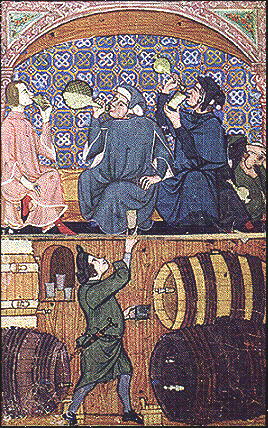Originally posted by Allison D. Reid:
The medieval tavern is fixed in our imaginations as a warm and festive place, where one could while away a cold, wet night in relative comfort. An abundance of food, drink, friends, and entertainment made the tavern a perfect place to gather after a long, hard day of work or travel. But were medieval taverns really like this, or is this only a fantasy image that we perpetuate in books and movies?
It might surprise you that taverns weren’t necessarily in one particular building run by a tavern keeper. Drinking was a popular recreational activity for both men and women, though there was often little time for recreation. Going to a tavern might simply mean going to the home of a neighbor who had recently brewed a batch of cheap ale. There might in fact be a number of neighbors along the same street with fresh brews ready for drinking. They would post a sign outside their door when it was ready, and turn their homes into temporary taverns. People from the community would show up and pay for the ale they drank while socializing with each other. Gambling with dice or cards, fights, and alcohol-related accidents were fairly common. Court records from the time describe the worst of these incidents in gruesome detail.
Brewing could be practiced freely by anyone, but it was typically a job for women. Even poor women could brew since not much equipment beyond a large cauldron was needed. Barley, oats, wheat, and malt were all used in ale production. It was regulated by the manorial lords only in the sense that its quality was regularly tested, and those whose who made weak or inferior ale with badly measured ingredients were fined. Sometimes those fines were waived when the brewer was exceedingly poor.
 Commercially established taverns, on the other hand, were more likely to serve wine than beer or ale, and catered to the wealthy rather than the average commoner. Some had their own vineyard or were closely connected with one. Simple foods would be offered, but very rarely lodging. (Inns were an entirely separate establishment that served food and alcohol as well.) Over time, taverns were enlarged to include multiple rooms and a large storage cellar. Despite the upscale clientele of taverns, gambling and fighting were typical, as was prostitution and sometimes other criminal activity.
Commercially established taverns, on the other hand, were more likely to serve wine than beer or ale, and catered to the wealthy rather than the average commoner. Some had their own vineyard or were closely connected with one. Simple foods would be offered, but very rarely lodging. (Inns were an entirely separate establishment that served food and alcohol as well.) Over time, taverns were enlarged to include multiple rooms and a large storage cellar. Despite the upscale clientele of taverns, gambling and fighting were typical, as was prostitution and sometimes other criminal activity.One misconception is that these establishments were open long hours into the night. On the contrary, cities and towns, particularly large ones, had strict curfew laws in place, as well as laws regulating the carrying of weapons. These were designed to prevent problems and keep crime to a minimum. When the curfew bell was rung at dusk, it was time to close up for the night and clear the streets. Anyone out after dark was required to have both a light and a very good reason for being there! These laws were enforced, so those who owned commercial taverns or operated ale houses from their homes either had to kick everyone out, or be prepared to accommodate them for the entire night.
When it comes to writing fiction, most authors don’t restrict the nightlife of their worlds so tightly. But unless you’re writing historical fiction, that doesn’t really matter. Your world, your rules! Still, it is interesting to know how things were really done back in the day. Also, though I didn’t find any specific information pertaining to small villages or rural areas, I would imagine they were less regulated than areas with larger populations.
Use the Medieval Monday Index to discover more topics relating to daily life in the Middle Ages.



No comments:
Post a Comment